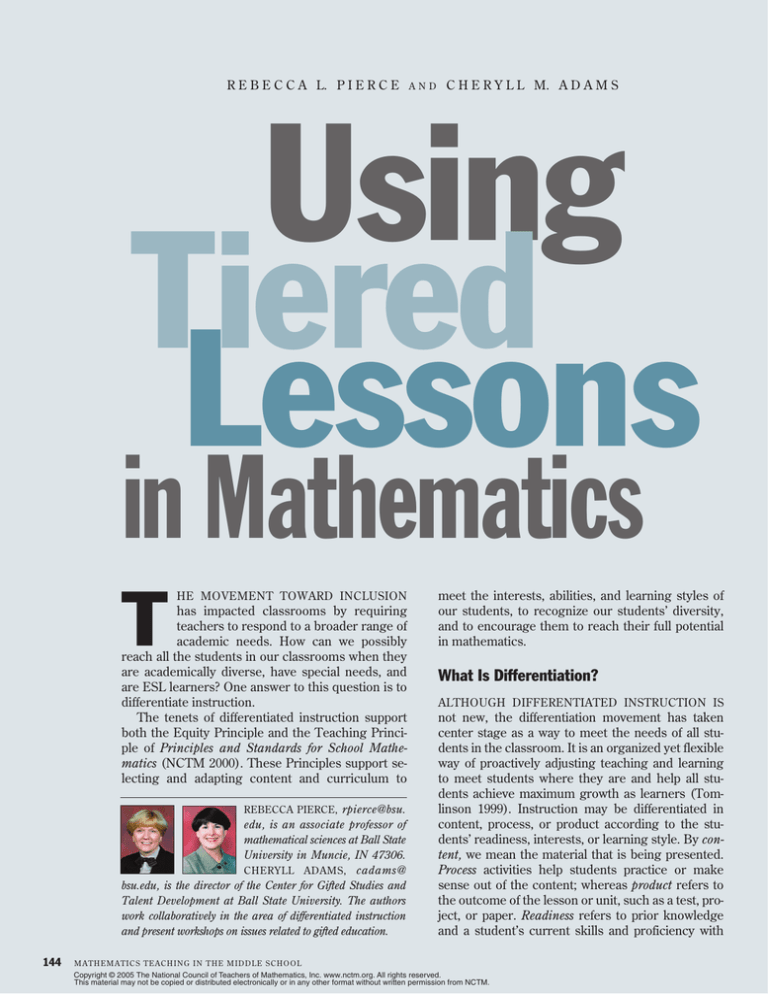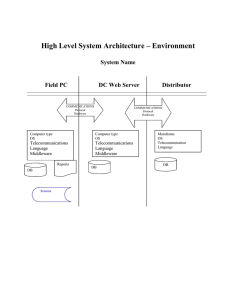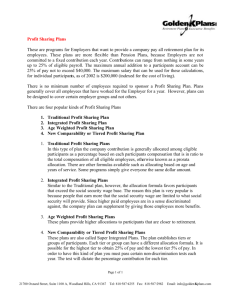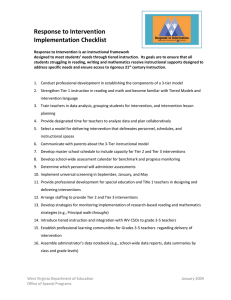
R E B E C C A L. P I E R C E
AND
C H E R Y L L M. A D A M S
Using
Tiered
Lessons
in Mathematics
T
HE MOVEMENT TOWARD INCLUSION
has impacted classrooms by requiring
teachers to respond to a broader range of
academic needs. How can we possibly
reach all the students in our classrooms when they
are academically diverse, have special needs, and
are ESL learners? One answer to this question is to
differentiate instruction.
The tenets of differentiated instruction support
both the Equity Principle and the Teaching Principle of Principles and Standards for School Mathematics (NCTM 2000). These Principles support selecting and adapting content and curriculum to
REBECCA PIERCE, rpierce@bsu.
edu, is an associate professor of
mathematical sciences at Ball State
University in Muncie, IN 47306.
CHERYLL ADAMS, cadams@
bsu.edu, is the director of the Center for Gifted Studies and
Talent Development at Ball State University. The authors
work collaboratively in the area of differentiated instruction
and present workshops on issues related to gifted education.
144
meet the interests, abilities, and learning styles of
our students, to recognize our students’ diversity,
and to encourage them to reach their full potential
in mathematics.
What Is Differentiation?
ALTHOUGH DIFFERENTIATED INSTRUCTION IS
not new, the differentiation movement has taken
center stage as a way to meet the needs of all students in the classroom. It is an organized yet flexible
way of proactively adjusting teaching and learning
to meet students where they are and help all students achieve maximum growth as learners (Tomlinson 1999). Instruction may be differentiated in
content, process, or product according to the students’ readiness, interests, or learning style. By content, we mean the material that is being presented.
Process activities help students practice or make
sense out of the content; whereas product refers to
the outcome of the lesson or unit, such as a test, project, or paper. Readiness refers to prior knowledge
and a student’s current skills and proficiency with
MATHEMATICS TEACHING IN THE MIDDLE SCHOOL
Copyright © 2005 The National Council of Teachers of Mathematics, Inc. www.nctm.org. All rights reserved.
This material may not be copied or distributed electronically or in any other format without written permission from NCTM.
nt
Ac
sr
oo
Te m
ch M
ni ana
qu g
e s em
e
g
in
or
ch
An
tiv
e
iti
Cl
as
s
r
e
if f
D
na
l
ct
io
tia
en
te
d
s
As
e
en
tia
St ted
ra I
t
eg nst
ie r u
s
m
ss
r
t
en
D
if f
e
CIRCLE
MAP ©
Fig. 1 An illustration of the CIRCLE MAP, which stands for
Creating an Integrated Response for Challenging Learners
Equitably: A Model by Adams and Pierce
the material presented in the lesson. A student’s interests may be assessed with an interest inventory
for the particular topic being studied or by an individual conversation with the student. Many teachers
use multiple intelligences as ways to characterize
learning styles (Armstrong 1994; Gardner 1993; Martin 1996). A variety of instruments can determine a
student’s learning style. (Two good interactive instruments may be found at www.ldpride.net.)
Having worked with preservice and in-service
teachers at a university laboratory school over the
last decade on implementing differentiated instruction, we noticed several commonalities among the
successful teachers. As a result, we have developed
a model: Creating an Integrated Response for Challenging Learners Equitably: A Model by Adams and
Pierce (CIRCLE MAP). The CIRCLE MAP, shown
in figure 1, is appropriate at any grade level and
content area. It interweaves four elements—classroom management techniques, anchoring activities, differentiated instruction strategies, and differentiated assessment. With this model, all students
engage in meaningful, respectful work at a moderately challenging level. For differentiation of instruction to occur successfully, the teacher moves
from being the dispenser of knowledge to a facilitator of knowledge; the student moves from being a
consumer of knowledge to a producer.
The Classroom Management Component
THE CLASSROOM MANAGEMENT COMPONENT
of the CIRCLE MAP must include rules for working
in a variety of configurations. Flexible grouping
arrangements, such as pairs, triads, or quads, as
well as whole-group and small-group instruction,
create opportunities to meet individual needs. A
flexible use of time allows lessons to proceed to
their natural conclusion rather than be carried out
in set blocks of time.
Since you can only work with one group or individual at a time, we have found two critical rules
that prevent confusion and preserve sanity. The
first rule, “Use six-inch voices,” means that students should modulate their speaking level so that
their voices can only be heard six inches away. The
second rule is “Ask three before me.” If students
need help completing a task or come to a stumbling
block, they should ask three other students first. If
these students cannot answer the question, the student has permission to ask the teacher.
The Anchoring Component
STUDENTS ARE GIVEN ANCHORING ACTIVITIES,
also called sponge activities, to use when they are
waiting for help before going any further or have
completed their work and are waiting to begin the
next lesson. They are also used at the beginning of
the class period to get students ready to work.
These activities include relevant extension and enrichment work, individual assignments, practice
with specific skills, and teacher-selected and student-selected activities. Anchoring activities replace
“I’m done” thinking with “What’s next?” Students
know that it is always safe to work on an anchoring
activity—they may get redirected later by the
teacher, but they will not get in trouble when doing
an anchoring activity.
The Differentiated Instruction
Strategies Component
A WIDE VARIETY OF STRATEGIES CAN BE USED
to differentiate instruction (see Gregory and Chapman 2002; Heacox 2002; Smutny, Walker, and
Meckstroth 1997; Tomlinson 1999; and Winebrenner 1992 for a discussion of other strategies).
However, the focus of this article is on a specific
strategy—tiered lessons. Tomlinson (1999) describes tiered lessons as “the meat and potatoes of
differentiated instruction.” A tiered lesson is a differentiation strategy that addresses a particular
standard, key concept, and generalization, but allows several pathways for students to arrive at an
understanding of these components, based on the
students’ readiness, interests, or learning styles. A
lesson tiered by readiness level implies that the
teacher has a good understanding of the students’
ability levels with respect to the lesson and has
V O L . 1 1 , N O . 3 . OCTOBER 2005
145
designed the tiers to meet those needs. Think of a
wedding cake with tiers of varying sizes. Many examples of lessons tiered in readiness have three
tiers: below grade level, at grade level, and above
grade level. However, no rule states that there may
be only three tiers. The number of tiers depends
on the range of ability levels in the specific classroom. Tiers are formed based on our assessment
of our students’ abilities to handle the material particular to a lesson. Students are regrouped when
we use a different tiering strategy. When the lesson is tiered by interest or learning style, we are
looking at student characteristics other than ability level. For example, the lesson might be tiered
to focus on three learning styles: auditory, visual,
and kinesthetic. Students would then be placed in
the tier that best matches their learning style, and
their ability levels will be varied. In these instances, we are giving all students choices of content, process, or product that are at about the same
level. These tiers are similar to those in a layer
cake—they are all the same size.
The number of groups per tier will vary, as will
the number of students per tier. We are not looking
to form groups of equal size; we are trying to form
groups based on the needs of individual students.
For example, tier 1 may have two groups of three
students; tier 2 may have five groups of four students; and tier 3 may have one group of two students. When the lesson is tiered by interest or
learning style, the same guidelines apply for forming groups—different tiers may have varying numbers of students.
The Differentiated Assessment Component
ASSESSMENT SHOULD BE FORMATIVE, SUMMA-
tive, or a combination. The teacher may observe the
students as they share their answers during a discussion and jot down notes for a formative assessment of each student or record observations of the
various groups on flip cards or sticky notes. For example, which child is struggling with the concept?
Which child is moving rapidly and accurately
through the material? Whose answers show more
thought and insight? Answers to these and other
questions will help you determine who needs
reteaching and who is ready to go on.
Culminating or summative assessments are
given at the end of a unit or large block of study.
The teacher could develop a rubric based on a particular product that is developed. The teacher may
give a formal paper-and-pencil test with a core block
of questions that all students must attempt and a
block of questions from which students can select
the specific ones they will answer to accumulate the
146
MATHEMATICS TEACHING IN THE MIDDLE SCHOOL
necessary points. The form of assessment you
choose should be based on the lesson design and
the purpose of the instruction.
How to Tier a Lesson
TO TAKE A CLOSER LOOK AT THE ANATOMY OF A
tiered lesson, we have included a mathematics lesson (shown in fig. 2), which was developed for the
Indiana Department of Education and field-tested
by teachers in the state. When developing a tiered
lesson, we found the eight steps described below to
be useful.
First, identify the grade level and subject for which
you will write the lesson. In this case, the grade level
is seventh, and the subject is mathematics.
Second, identify the standard (national, state, district, and so on) that you are targeting. A common
mistake for those just beginning to tier is to develop
three great activities and then try to force fit them
into a tiered lesson. Start with the standard first. If
you do not know where you are going, how will you
know if you get there? The author of this lesson has
selected the Measurement Standard from Principles
and Standards for School Mathematics (NCTM
2000, pp. 240–47).
Third, identify the key concept and generalization.
The key concept follows from the standard. Ask
yourself, “What big idea am I targeting?” In this example, students are to work with measurement of
perimeter and area. Although many concepts could
be covered under the standard that was chosen,
this lesson addresses only one. The generalization
follows from the concept chosen. Ask yourself,
“What do I want the students to know at the end of
the lesson, regardless of their placement in the
tiers?” In this lesson, all students work with the relationship between the perimeter and area of shapes.
Fourth, be sure students have the background necessary to be successful. What scaffolding is necessary? What must you have already covered or what
must the student have already learned? Are there
other skills that must be taught first? For this lesson, students should be familiar with the concepts
of perimeter and area.
Fifth, determine which part of the lesson (content,
process, or product) you will tier. You may choose
to tier the content (what you want the students to
learn), the process (the way students make sense
out of the content), or the product (the outcome at
the end of a lesson, lesson set, or unit—often a
Grade: Seventh
Subject: Mathematics
Standard: Measurement
Key Concept: Students work with measurement of perimeter and area.
Generalization: Students see the relationship between perimeter and area of shapes.
Background: This lesson should be presented fairly early in the year. Students should be familiar with
the concepts of perimeter and area. The materials needed are multicolored paper squares and hexagons.
Tier 1: Below Grade Level Learners
Pairs of students are given eight squares that are a variety of colors; you could have the students make
their own squares from card stock, or you may already have an appropriate manipulative for the students
to use. Students are given a worksheet that contains a series of questions about perimeter and area related to the eight squares. Questions about the greatest and least perimeter, greatest and least area, specific areas, and specific perimeters should be included on the worksheet. In addition, students should be
asked to draw specific examples for each question.
Tier 2: Grade Level Learners
Pairs of students are given twelve squares that are a variety of colors; you could have the students make
their own squares from card stock, or you may already have an appropriate manipulative for the students
to use. Students are given a worksheet that contains a series of questions about perimeter and area related to the twelve squares. Questions about the greatest and least perimeter, greatest and least area, specific areas, and specific perimeters should be included on the worksheet. In addition, students should be
asked to draw specific examples for each question.
Tier 3: Above Grade Level Learners
Pairs of students are given twelve hexagons that are a variety of colors; you could have the students make
their own hexagons from card stock, or you may already have an appropriate manipulative for the students to use. Students are given a worksheet that contains a series of questions about perimeter and area
related to the use of the twelve hexagons. Questions about the greatest and least perimeter, greatest and
least area, specific areas, and specific perimeters should be included on the worksheet. In addition, students should be asked to draw specific examples for each question.
Assessment: Each worksheet should be graded for accuracy. An extension for each tier would be to ask
questions that involve a greater number of their shape or pertain to another shape.
Fig. 2 A lesson tiered in content according to readiness
project). When beginning, we suggest that you tier
only one of these three. Once you are comfortable
with the process, you might try to tier more than
one part in the same lesson. This lesson is tiered
in content.
Sixth, determine the type of tiering: readiness, interest, or learning style. Readiness is based on the
ability levels of the students. Giving a pretest is a
good way to assess readiness. Interest is based on
students’ interest in a topic, generally gauged
through a survey. Learning style may be determined
through various learning style inventories. In this
lesson, the author chose readiness.
Seventh, based on your choices above, determine
how many tiers you will need and develop the lesson.
When tiering according to readiness, you may have
three tiers: below grade level, at grade level, and
above grade level. If you choose to tier in interest
or learning style, you may control the number of
tiers by limiting choices or using only a few different learning styles. For example, one could choose
visual, auditory, and kinesthetic learning preferences. For this lesson, students are placed in one of
three tiers based on their ability to work with
perimeter and area as assessed by the teacher
through observation.
Differentiation means doing something qualitatively different for each tier group. Make sure you
keep this in mind when tiering the lessons. Second,
be sure that each tier is doing moderately challenging, respectful, and developmentally appropriate
V O L . 1 1 , N O . 3 . OCTOBER 2005
147
Grade: Sixth
Subject: Mathematics
Standard: Connections
Key Concept: Students use technology, such as computers and calculators, as tools to model patterns.
Generalization: Students create and use mathematical objects to make patterns.
Background: Students have worked with number patterns and have observed patterns of geometric objects. This lesson would most likely be appropriate toward the end of the academic year. Within each tier,
the teacher may choose to have the students work in pairs, triads, or quads.
Tier 1: Visual Learners
Groups of students are given a picture from nature, wrapping paper, or other visual item that contains a
definite pattern. The students use the item to create the same pattern with numbers using the calculator
or a new visual using the computer that conveys the same pattern. Students must write at least one paragraph justifying how and why the new item represents the same pattern found in the original item.
Tier 2: Auditory Learners
Groups of students listen to a musical piece or song that has a definite pattern. The students use the
music to create the same pattern with numbers using the calculator or a new visual using the computer
that conveys the same pattern. Students must write at least one paragraph justifying how and why the
new item represents the same pattern found in the music.
Tier 3: Kinesthetic Learners
Students are taught the steps for the cha-cha or rumba or some other dance that has a definite pattern.
The students use the dance to create the same pattern with numbers using the calculator or a new visual
using the computer that conveys the same pattern. Students must write at least one paragraph justifying
how and why the new item represents the same pattern found in the dance.
Assessment: This lesson is meant to be a fun way to consider patterns and provide extra practice working with numbers, geometric objects, calculators, and computers. Although an assessment is not necessary, you may want to grade the project using a rubric based on students’ justifications, ability to work cooperatively, and on originality and creativity.
Fig. 3 A lesson tiered in process according to learning style
work. In other words, no group should be given
busy work. We do not want one group doing blackline practice sheets and another doing an exciting
activity.
Notice in this lesson that all three tiers are working on perimeter and area. Students in each tier use
a specific number of a particular geometric shape to
answer a series of questions about perimeter and
area. In other words, the content for each tier in the
sample lesson, beginning in tier 1 and moving
through tier 3, differs from simple to complex and
from foundational to transformational, to use Tomlinson’s equalizer word pairs (Tomlinson 1999).
Tier 1 is the lowest level; tier 3 is the highest level.
Eighth and last, develop the assessment component
to the lesson. The assessment can be formative, summative, or a combination of both. Since the standards support both formal and informal assessment, you may record observations of the various
groups, develop a rubric for each product that is
created, or give a formal paper-and-pencil test
148
MATHEMATICS TEACHING IN THE MIDDLE SCHOOL
(NCTM 2000, p. 22). Choose the assessment based
on your needs and lesson design. A formal assessment, grading each worksheet for accuracy, is used
here to determine each student’s understanding of
perimeter and area.
The second sample lesson, figure 3, is tiered in
content according to learning style. In this case, students are grouped heterogeneously based on one of
three learning preferences: auditory, kinesthetic, or
visual. The same eight steps for tiering a lesson
apply in this case. In the second lesson, notice that
the activities are at the same approximate level of
complexity. This would be the “layer cake” model
as opposed to the “wedding cake” model used when
tiering according to readiness.
Final Thoughts
TIME, ENERGY, AND PATIENCE ARE REQUIRED TO
learn to effectively differentiate instruction in an
academically diverse classroom. In addition, you
need administrative and peer support, as well as
professional development over extended periods of
time. Do not expect to have a differentiated classroom by Monday morning. Start small; choose a favorite lesson in your next unit and differentiate it according to the needs of your students. Seek the
expertise of specialists such as special and gifted
education coordinators, media specialists, and others to collaborate to improve instruction in an academically diverse classroom.
References
Armstrong, Thomas. Multiple Intelligences in the Classroom. Alexandria, VA: ASCD, 1994.
Gardner, Howard. Multiple Intelligences: The Theory and
Practice. New York: BasicBooks, 1993.
Gregory, Gail, and Carolyn Chapman. Differentiated Instructional Strategies: One Size Doesn’t Fit All. Thousand Oaks, CA: Corwin, 2002.
Heacox, Diane. Differentiating Instruction in the Regular
Classroom. Minneapolis: Free Spirit, 2002.
Martin, Hope. Multiple Intelligences in the Mathematics
Classroom. Palatine, IL: IRI/SkyLight, 1996.
National Council of Teachers of Mathematics (NCTM).
Principles and Standards for School Mathematics.
Reston, VA: NCTM, 2000.
Smutny, Joan, Sally Walker, and Elizabeth Meckstroth.
Teaching Young Gifted Children in the Regular Classroom. Minneapolis: Free Spirit, 1997.
Tomlinson, Carol. The Differentiated Classroom: Responding to the Needs of All Learners. Alexandria, VA: ASCD,
1999.
Winebrenner, Susan. Teaching Gifted Kids in the Regular
Classroom. Minneapolis: Free Spirit, 1992.
Research for this article was funded in part by the Indiana
Department of Education. Further information can be
found at doe.state.in.us/exceptional/gt/tiered_curriculum/
welcome.html. V O L . 1 1 , N O . 3 . OCTOBER 2005
149





